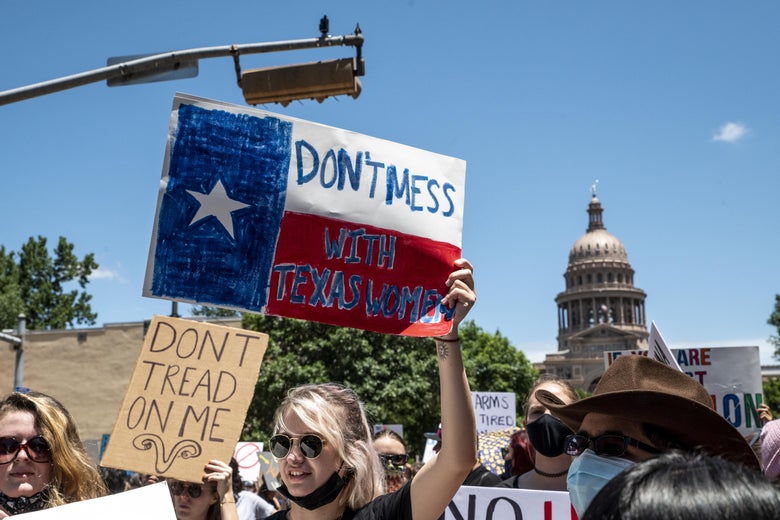begin quote from:
Of Course This Supreme Court Ended Roe v. Wade by Doing Nothing
The conservative justices excel at overturning precedent without admitting it. This time, they didn’t have to say a word.
Perhaps it was inevitable that this Supreme Court would overturn Roe v. Wade, not with a momentous majority opinion, but by doing nothing. That’s all it took for the Supreme Court to let Texas’ six-week abortion ban take effect on Sept. 1: silence. As the clock ticked toward midnight, and anti-abortion protesters gathered outside Texas clinics to harass patients and staff, the justices kept mum. A few hours later, the country woke up to its post-Roe future.
At this moment, any person can sue anyone who “aids or abets” an abortion that takes place in Texas after six weeks of pregnancy—which is when more than 85 percent of abortions are performed—for a minimum of $10,000, plus attorneys’ fees. Any person can sue a clinic that performs these abortions and obtain a court order shutting it down. There is now a $10,000 bounty on the heads of every individual who facilitates abortion, including friends, family members, counselors, even clergy who support a patient’s decision to terminate. Anyone who forms the mere intent to “abet” an abortion may be sued, even if they do not follow through. Texas devised a devious workaround to Roe by threatening abortion patients’ entire support network with bankruptcy. And the Supreme Court let it happen.
How did we get here? The answer can be boiled down to two names: Brett Kavanaugh and Amy Coney Barrett. Both justices are significantly more conservative than their predecessors—in Barrett’s case, the polar opposite—and both are comfortable manipulating the court’s procedures to reach radical results. At the same time, both justices excel in overruling precedent without acknowledging it. SCOTUS has already taken a case that will probably gut abortion rights by June 2022. But with its new law, Texas handed Kavanaugh and Barrett a gift: They could eviscerate Roe months earlier without writing a single word. The 5th U.S. Circuit Court of Appeals did the dirty work for SCOTUS by preventing a federal judge from blocking the ban or even holding a hearing on its constitutionality. All the justices had to do was nothing.
The court’s inaction is especially galling in light of its aggressive intervention in cases it deems important. SCOTUS has treated case after case as an emergency in need of immediate resolution. It raced to block blue states’ COVID restrictions, it ended the CDC’s eviction moratorium in the midst of the delta surge, and it continually cleared away lower court decisions blocking Donald Trump’s extreme cutbacks on legal immigration. To the conservative justices, these policies qualified as an emergency. Texas’ abortion ban, it seems, does not. By refusing to lift a finger, the Supreme Court has telegraphed to the states that it does not view an illegal assault on abortion rights as a pressing matter requiring immediate attention. It gave the green light to impatient red states that won’t wait for SCOTUS to reverse precedent. These states can pass blatantly unconstitutional laws, persuade far-right judges not to block them, and count on the Supreme Court to stay out of it.
In February, Cardozo Law professor and Strict Scrutiny co-host Kate Shaw mused that the Supreme Court might “overrule Roe in the shadow docket,” adding that “right now, there’s nothing stopping them but potentially public opinion and blowback.” After Texas’ law took effect, though, there was remarkably little blowback outside the small world of lawyers, commentators, and advocates laser-focused on reproductive rights. Initially, the New York Times and the Washington Post treated the court’s inaction as a below-the-fold story. It took several hours on Wednesday morning for much of the media to catch up with the fact that SCOTUS allowed a state to ban abortion. And this, we can assume, is exactly how the conservative justices wanted to end Roe: not with a bang, or even a whimper, but with silence, confusion, and queasy uncertainty.
Within a few hours or days, the Supreme Court will likely issue an order in this case. By that point, clinics will have canceled hundreds, if not thousands, of patients’ appointments. So much damage has already been done, and we do not even know which justices to blame. There is presumably some battle raging behind the scenes at SCOTUS, dueling opinions flying back and forth between each wing of the court. But we will not see it. We do not even get the transparency of oral arguments and full briefing. The court has chosen to deal with this case in the dark. And it could not be bothered to reach a resolution before the fallout from the law began. No wonder a key proponent of the Texas bill is already boasting that he plans to introduce identical measures in other GOP-controlled states.
The conservative majority has spent several years amassing the power to intervene in any legal dispute that catches its eye. It has transformed the shadow docket into a roving veto. On Tuesday night, faced with a clear-cut violation of a nearly 50-year precedent—the rare instance of a state flouting constitutional precedent and getting away with it in the lower courts—the conservative justices declined to exercise this power. At a bare minimum, the monumental conflict over reproductive autonomy deserved a full and fair hearing in open court. Instead, the Supreme Court has let an established constitutional right die in the shadows.


No comments:
Post a Comment